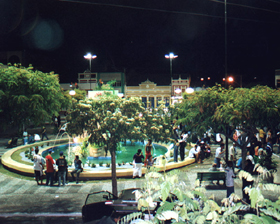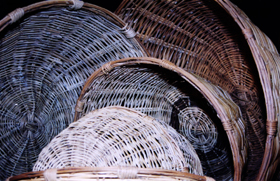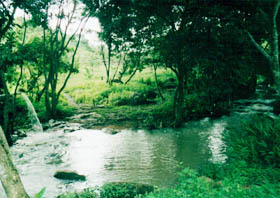|
|
Belo Jardim - Pernambuco
«Recife
« Cities of Pernambuco
Population: 68.698 inhabitants
Area: 648 km2
Distance from the capital: 180 km
Accesses: BR-232 (the highway is double-laned as far as Caruaru). Visit the section maps of Recife and Pernambuco for more info.
History
The name Belo Jardim means "Beautiful Garden" in Portuguese.
The city of Belo Jardim had its origin in the Fazenda Capim (Grass Farm). The area had an expressive growth in the beginning of the 20th century thanks to the railways which were laid in the State of Pernambuco (later on, the railways were de-activated).
 In September 11th of 1928, by force of Law 1931, the city of Brejo da Madre de Deus was splitted, and of the divisions became Belo Jardim.
In September 11th of 1928, by force of Law 1931, the city of Brejo da Madre de Deus was splitted, and of the divisions became Belo Jardim.
Economy
One of the main economic activities of Belo Jardim is embroidering.
The embroider women of Belo Jardim push the local economy by selling their work, like blouses, towels, stair carpets and others. The production of straw baskets (pictures), pieces of ropes, urupembas and pottery are also relevant for the economy of the city.
 Tourists from many States come to Belo Jardim in search of the handicraft. The tourism boosts the economy of the region, mostly during the Carnaval (Carnival) and the religious festivals.
Tourists from many States come to Belo Jardim in search of the handicraft. The tourism boosts the economy of the region, mostly during the Carnaval (Carnival) and the religious festivals.
The municipal district of Belo Jardim is part of the Development Region of the Central Agreste (see map of Pernambuco), located in the Pernambuco Agreste Mesoregion. With an area of 10.117 km², the region of Central Agreste covers 10,22% of the State territory and its constituted by 25 municipal districts: Agrestina, Alagoinha, Altinho, Barra de Guabiraba, Bezerros, Bonito, Brejo da Madre de Deus, Cachoeirinha, Camocim de São Félix, Caruaru, Cupira, Gravatá, Ibirajuba, Jataúba, Lagoa dos Gatos, Panelas, Pesqueira, Poção, Riacho das Almas, Sairé, Sanharó, São Bento do Una, São Caetano, São Joaquim do Monte and Tacaimbó.
Tourism
 The city of Belo Jardim is home of enticing natural attractions. Among them, the Cachoeira Engenho Tira-Teima, a waterfall 20 meters high ("engenho" is the name of the old sugar-cane production farms); a portion of the water is used by the engenho to move the engines which squeeze the cane.
The waterfall isn't promising to bath, otherwise to follow it's stretch is a good option to appreciate the local natural beauty.
The city of Belo Jardim is home of enticing natural attractions. Among them, the Cachoeira Engenho Tira-Teima, a waterfall 20 meters high ("engenho" is the name of the old sugar-cane production farms); a portion of the water is used by the engenho to move the engines which squeeze the cane.
The waterfall isn't promising to bath, otherwise to follow it's stretch is a good option to appreciate the local natural beauty.
Cachoeira do Engenho is not suitable for bathing. Fo those who want to freshen up, a good option is the nearby Corredeira da Espalhadeira, with many natural pools.
Also worthy a visit is the Cachoeira do Bitury (Bitury Waterfall). Located in the middle of a fertile ground and thicket, the Cachoeira do Bitury is actually formed by a sequence of two waterfalls; the first and larger one is 7m high and 15 m large. From them, the water splashes on the top of three rocky plateaus, before reaching the second waterfall, at about 1,5m high. Visitors can bath, in a truly impressive natural shower.
Another natural attraction of Belo Jardim is the Serra do Caboclo, with a vegetation dominated by bromélias, cactáceas and creeping vegetation.
In September, the city promotes the Jardim Cultural (Cultural Garden), an event with shows of national and regional artists, artistic workshops, exhibitions and regional dance shows.
Other sites:
Belo Jardim in the Pernambuco's Guide Informations about Belo Jardim, including several pictures
Source of information: IBGE and Government of Pernambuco
Pictures credits: Government of the State of Pernambuco.
|
|